外文文献翻译:汽车的发展
汽车历史发展的有关介绍英语作文
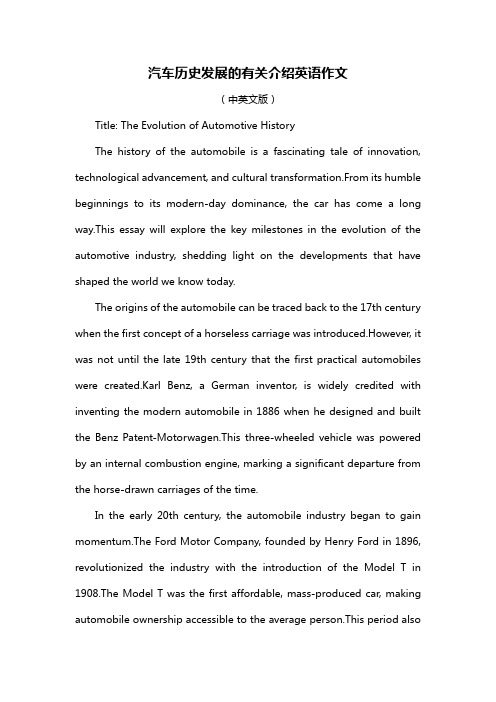
汽车历史发展的有关介绍英语作文(中英文版)Title: The Evolution of Automotive HistoryThe history of the automobile is a fascinating tale of innovation, technological advancement, and cultural transformation.From its humble beginnings to its modern-day dominance, the car has come a long way.This essay will explore the key milestones in the evolution of the automotive industry, shedding light on the developments that have shaped the world we know today.The origins of the automobile can be traced back to the 17th century when the first concept of a horseless carriage was introduced.However, it was not until the late 19th century that the first practical automobiles were created.Karl Benz, a German inventor, is widely credited with inventing the modern automobile in 1886 when he designed and built the Benz Patent-Motorwagen.This three-wheeled vehicle was powered by an internal combustion engine, marking a significant departure from the horse-drawn carriages of the time.In the early 20th century, the automobile industry began to gain momentum.The Ford Motor Company, founded by Henry Ford in 1896, revolutionized the industry with the introduction of the Model T in 1908.The Model T was the first affordable, mass-produced car, making automobile ownership accessible to the average person.This period alsosaw the rise of other major automakers, such as General Motors and Chrysler, who helped to establish the United States as the world"s leading force in automobile production.The 1950s and 1960s were a golden age for the automobile industry.The post-World War II economic boom led to a surge in automobile sales, as more and more families could afford their own cars.This era was characterized by innovation, with the development of new technologies such as automatic transmissions, power steering, and air conditioning.The "Muscle Cars" of this era, with their powerful engines and sleek designs, became a symbol of American culture and freedom.However, the 1970s brought about a period of significant change in the automotive industry.The OPEC oil embargo of 1973 led to a surge in oil prices, causing a shift in consumer preferences towards smaller, more fuel-efficient cars.This shift was further exacerbated by environmental concerns and regulations, which led to the development of the first fuel-efficient "Economy Cars."In the subsequent decades, the automobile industry continued to evolve, with the emergence of new technologies and the rise of international competition.The introduction of the hybrid vehicle in the late 20th century, led by companies like Toyota and Honda, marked a significant step towards more sustainable transportation.The 21stcentury has seen the rise of electric vehicles (EVs), led by companies like Tesla, which are poised to reshape the automotive landscape once again.In conclusion, the history of the automobile is a story of continuous innovation and adaptation.From the early horseless carriages to the modern EVs, the car has become an integral part of our daily lives.As we look to the future, it is clear that the automobile industry will continue to evolve, with new technologies and sustainable practices driving the next wave of innovation.。
车的发展历史英语作文
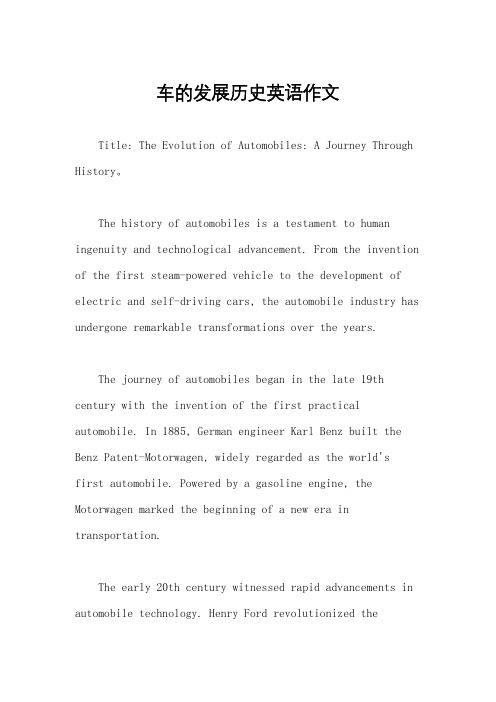
车的发展历史英语作文Title: The Evolution of Automobiles: A Journey Through History。
The history of automobiles is a testament to human ingenuity and technological advancement. From the invention of the first steam-powered vehicle to the development of electric and self-driving cars, the automobile industry has undergone remarkable transformations over the years.The journey of automobiles began in the late 19th century with the invention of the first practical automobile. In 1885, German engineer Karl Benz built the Benz Patent-Motorwagen, widely regarded as the world'sfirst automobile. Powered by a gasoline engine, the Motorwagen marked the beginning of a new era in transportation.The early 20th century witnessed rapid advancements in automobile technology. Henry Ford revolutionized theindustry with the introduction of the assembly line production system, which made cars more affordable and accessible to the masses. The Ford Model T, introduced in 1908, became one of the most iconic vehicles of the era and played a significant role in shaping modern transportation.The 1920s and 1930s saw further innovations in automobile design and engineering. Manufacturers began experimenting with new materials and technologies to improve performance, safety, and comfort. Streamlined designs and aerodynamic principles were incorporated into car designs, leading to faster and more fuel-efficient vehicles.The post-World War II period marked another significant milestone in automotive history. The economic boom of the 1950s fueled consumer demand for automobiles, leading to the mass production of cars with sleek designs and powerful engines. The rise of suburban living and the construction of interstate highways further contributed to thepopularity of automobiles as a primary mode of transportation.The latter half of the 20th century saw growingconcerns about environmental pollution and fuel consumption, prompting manufacturers to explore alternative propulsion systems. In the 1970s, the oil crisis prompted a renewed interest in fuel-efficient vehicles, leading to the development of hybrid and electric cars.The 21st century has witnessed unprecedented advancements in automotive technology. Electric vehicles (EVs) have gained popularity as concerns about climate change and air pollution have intensified. Major automakers are investing heavily in EV technology, leading to the development of long-range electric vehicles with rapid charging capabilities.Furthermore, the concept of autonomous vehicles has captured the imagination of both consumers and industry experts. Companies like Tesla, Google, and Uber are leading the race to develop self-driving cars equipped with advanced sensors and artificial intelligence algorithms. While fully autonomous vehicles are still in the testingphase, they hold the potential to revolutionize transportation by reducing accidents, traffic congestion, and carbon emissions.In conclusion, the history of automobiles is a story of innovation, perseverance, and adaptation. From humble beginnings as steam-powered contraptions to the sophisticated electric and autonomous vehicles of today, automobiles have come a long way. As we stand on the brink of a new era of transportation, it is clear that the journey of automobiles is far from over, with new technologies and breakthroughs on the horizon.。
汽车的发展英文作文100
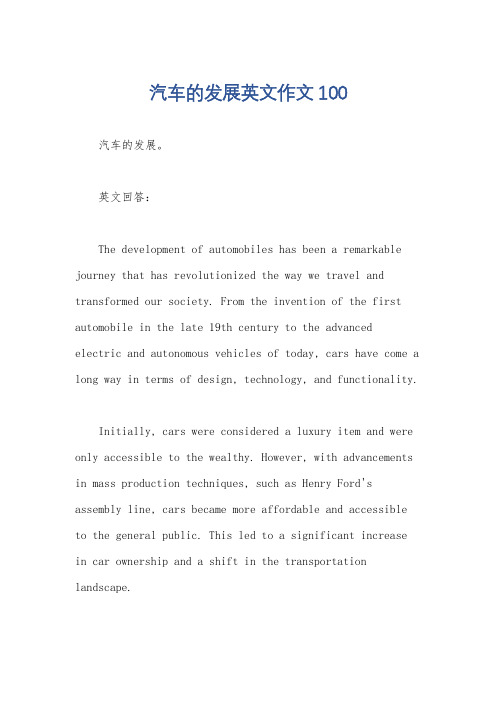
汽车的发展英文作文100汽车的发展。
英文回答:The development of automobiles has been a remarkable journey that has revolutionized the way we travel and transformed our society. From the invention of the first automobile in the late 19th century to the advancedelectric and autonomous vehicles of today, cars have come a long way in terms of design, technology, and functionality.Initially, cars were considered a luxury item and were only accessible to the wealthy. However, with advancements in mass production techniques, such as Henry Ford's assembly line, cars became more affordable and accessible to the general public. This led to a significant increasein car ownership and a shift in the transportation landscape.Over the years, cars have become more efficient and environmentally friendly. The introduction of hybrid and electric vehicles has addressed concerns about pollution and fossil fuel consumption. These vehicles utilize alternative sources of energy and emit fewer greenhouse gases, making them a sustainable option for the future.Furthermore, the development of autonomous vehicles has the potential to revolutionize transportation even further. Self-driving cars have the ability to navigate without human intervention, leading to improved safety, reduced traffic congestion, and increased productivity. Companies like Tesla and Google have made significant strides in this area, and it is only a matter of time before autonomous vehicles become a common sight on our roads.In addition to technological advancements, the design of cars has also evolved over time. From classic modelslike the Ford Mustang to sleek and futuristic designs like the Tesla Model S, cars have become a symbol of style and innovation. Car manufacturers are constantly pushing boundaries and incorporating cutting-edge features toattract consumers.中文回答:汽车的发展是一个令人瞩目的旅程,它彻底改变了我们的出行方式,改变了我们的社会。
汽车发展史的英文作文
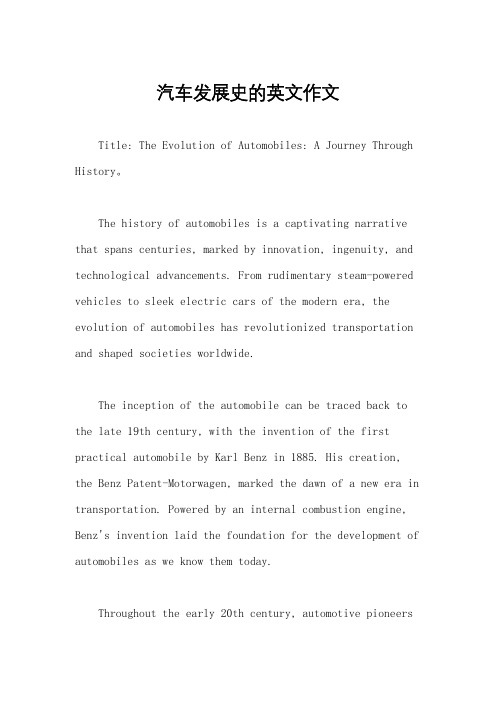
汽车发展史的英文作文Title: The Evolution of Automobiles: A Journey Through History。
The history of automobiles is a captivating narrative that spans centuries, marked by innovation, ingenuity, and technological advancements. From rudimentary steam-powered vehicles to sleek electric cars of the modern era, the evolution of automobiles has revolutionized transportation and shaped societies worldwide.The inception of the automobile can be traced back to the late 19th century, with the invention of the first practical automobile by Karl Benz in 1885. His creation, the Benz Patent-Motorwagen, marked the dawn of a new era in transportation. Powered by an internal combustion engine, Benz's invention laid the foundation for the development of automobiles as we know them today.Throughout the early 20th century, automotive pioneerssuch as Henry Ford played a pivotal role in popularizing automobiles and making them accessible to the masses.Ford's introduction of the assembly line revolutionized the manufacturing process, leading to increased production efficiency and lower costs. This, in turn, made cars more affordable for the average consumer, fueling the rapid growth of the automotive industry.The early decades of the 20th century also saw significant advancements in automotive technology,including the introduction of electric starters, pneumatic tires, and hydraulic brakes. These innovations not only improved the performance and safety of automobiles but also enhanced the overall driving experience.The mid-20th century witnessed further innovations in automotive design and engineering. The introduction of automatic transmissions, power steering, and air conditioning systems made cars more comfortable and convenient to drive. Meanwhile, advancements in aerodynamics and engine technology led to improvements in fuel efficiency and performance.The latter half of the 20th century saw a growing focus on environmental concerns and fuel efficiency. This prompted the development of alternative fuel vehicles, such as hybrid and electric cars. While these technologies were initially met with skepticism, they have since gained traction as concerns over climate change and fossil fuel dependency have intensified.In recent years, the automotive industry has witnessed a surge in innovation driven by digitalization and connectivity. The emergence of autonomous driving technologies, artificial intelligence, and internet-enabled features has transformed the way we interact with cars. Vehicles are now equipped with advanced driver assistance systems, GPS navigation, and entertainment options that were once unimaginable.Furthermore, the shift towards electric vehicles has gained momentum, with major automakers investing heavily in electrification initiatives. Electric cars offer numerous advantages, including lower emissions, reduced reliance onfossil fuels, and quieter operation. As battery technology continues to improve, the range and performance of electric vehicles are steadily increasing, making them a viable alternative to traditional combustion engine cars.Looking ahead, the future of automobiles promises even greater advancements and innovation. Emerging technologies such as hydrogen fuel cells, 3D printing, and advanced materials hold the potential to revolutionize the automotive industry once again. Moreover, the integration of smart infrastructure and vehicle-to-everything (V2X) communication systems will pave the way for safer, more efficient transportation networks.In conclusion, the history of automobiles is a testament to human creativity, perseverance, and ingenuity. From humble beginnings to cutting-edge innovations, the evolution of automobiles has shaped the course of history and transformed the way we live, work, and travel. As we stand on the cusp of a new era of mobility, the journey of the automobile continues to inspire and captivate us with endless possibilities for the future.。
汽车的发展英文作文
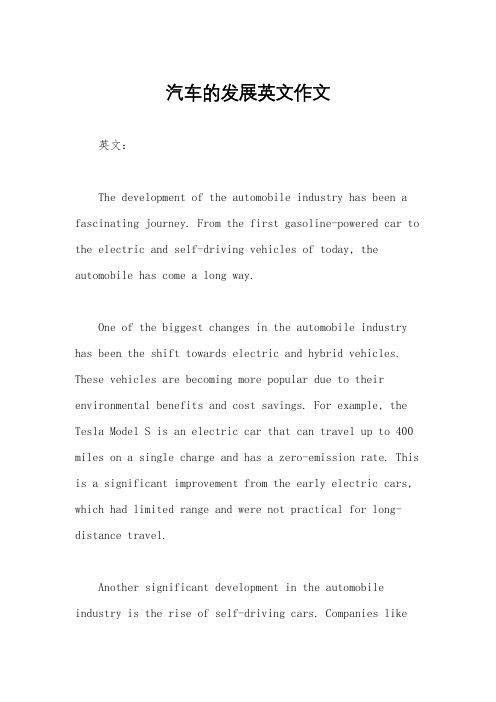
汽车的发展英文作文英文:The development of the automobile industry has been a fascinating journey. From the first gasoline-powered car to the electric and self-driving vehicles of today, the automobile has come a long way.One of the biggest changes in the automobile industry has been the shift towards electric and hybrid vehicles. These vehicles are becoming more popular due to their environmental benefits and cost savings. For example, the Tesla Model S is an electric car that can travel up to 400 miles on a single charge and has a zero-emission rate. This is a significant improvement from the early electric cars, which had limited range and were not practical for long-distance travel.Another significant development in the automobile industry is the rise of self-driving cars. Companies likeGoogle and Tesla are investing heavily in this technology, and it is predicted that self-driving cars will be a common sight on the roads within the next decade. Self-driving cars have the potential to reduce accidents caused by human error and increase the efficiency of transportation.Despite these advancements, there are still challenges facing the automobile industry. One of the biggest challenges is the need for improved infrastructure for electric and self-driving cars. Charging stations for electric cars need to be more widespread and accessible, and self-driving cars require specialized roads and infrastructure to operate safely.Overall, the development of the automobile industry has been a fascinating journey, and I am excited to see what the future holds.中文:汽车行业的发展历程是一个迷人的旅程。
汽车的历史发展英语作文
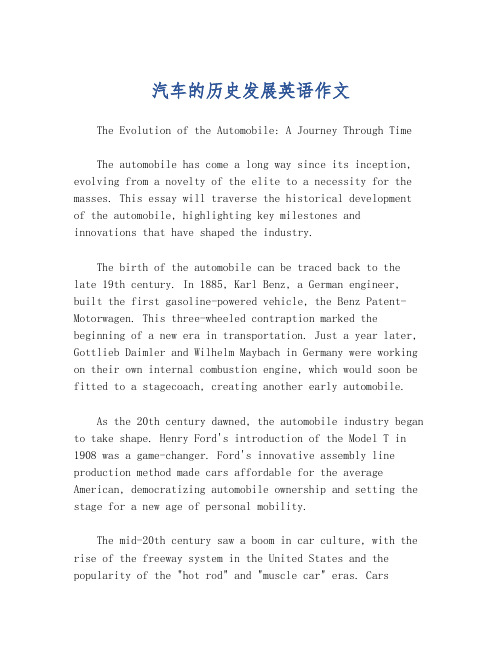
汽车的历史发展英语作文The Evolution of the Automobile: A Journey Through TimeThe automobile has come a long way since its inception, evolving from a novelty of the elite to a necessity for the masses. This essay will traverse the historical development of the automobile, highlighting key milestones and innovations that have shaped the industry.The birth of the automobile can be traced back to thelate 19th century. In 1885, Karl Benz, a German engineer, built the first gasoline-powered vehicle, the Benz Patent-Motorwagen. This three-wheeled contraption marked the beginning of a new era in transportation. Just a year later, Gottlieb Daimler and Wilhelm Maybach in Germany were working on their own internal combustion engine, which would soon be fitted to a stagecoach, creating another early automobile.As the 20th century dawned, the automobile industry began to take shape. Henry Ford's introduction of the Model T in 1908 was a game-changer. Ford's innovative assembly line production method made cars affordable for the average American, democratizing automobile ownership and setting the stage for a new age of personal mobility.The mid-20th century saw a boom in car culture, with the rise of the freeway system in the United States and the popularity of the "hot rod" and "muscle car" eras. Carsbecame not just a means of transportation but also a symbolof freedom, status, and personal expression.The 1970s brought a shift in focus towards safety and environmental concerns. The introduction of safetyregulations and emissions standards led to significant technological advancements. Cars became safer, more efficient, and more environmentally friendly, with the development of catalytic converters and airbags.The turn of the millennium heralded a new era ofinnovation with the rise of electric vehicles (EVs). Companies like Tesla have pushed the boundaries of what cars can do, focusing on sustainability and technological integration. The modern automobile is now a marvel of engineering, with capabilities ranging from self-driving technology to infotainment systems that connect drivers tothe digital world.In conclusion, the history of the automobile is a testament to human ingenuity and the relentless pursuit of progress. From its humble beginnings to its current status as a cornerstone of modern society, the automobile has undergone a remarkable transformation. As we look to the future, the potential for further innovation in areas such as autonomous driving and alternative energy sources holds the promise ofan even more exciting journey ahead.。
汽车发展的英文作文

汽车发展的英文作文英文回答:The automotive industry has witnessed remarkable progress throughout history, revolutionizing transportation and shaping modern society. From the rudimentary beginnings of steam-powered carriages to the advanced electric vehicles of today, the evolution of automobiles has been a testament to human ingenuity and technological advancement.Early automobiles emerged in the late 19th century, with inventors like Karl Benz and Gottlieb Daimler developing the first internal combustion engines. These early vehicles were cumbersome, unreliable, and often difficult to operate. However, as technology improved, automobiles became more accessible and affordable, leading to widespread adoption.The early 20th century saw significant advancements in automotive engineering, with the introduction of massproduction techniques and the development of more efficient engines. The Model T Ford, produced by Henry Ford, became an iconic symbol of the automobile's growing popularity.In the post-World War II era, the automotive industry experienced a surge of innovation, with the development of new materials, advanced electronics, and increased focus on safety and comfort. The 1950s and 1960s witnessed the rise of the muscle car and the introduction of iconic modelslike the Chevrolet Corvette and the Ford Mustang.The 1970s and 1980s brought challenges to the automotive industry with the oil crisis and increasing environmental concerns. These factors led to a shift towards smaller, more fuel-efficient vehicles, as well as the development of alternative fuel sources, such as hybrid and electric powertrains.The 21st century has seen the convergence of automotive technology and information technology, with the integration of advanced electronics and software into vehicles. This has led to the development of semi-autonomous drivingsystems, improved safety features, and enhanced connectivity.中文回答:汽车发展的简史。
汽车的发展英文作文100
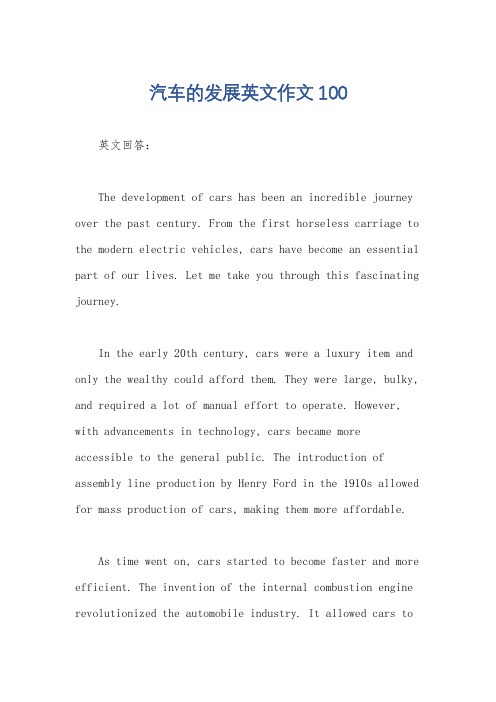
汽车的发展英文作文100英文回答:The development of cars has been an incredible journey over the past century. From the first horseless carriage to the modern electric vehicles, cars have become an essential part of our lives. Let me take you through this fascinating journey.In the early 20th century, cars were a luxury item and only the wealthy could afford them. They were large, bulky, and required a lot of manual effort to operate. However, with advancements in technology, cars became more accessible to the general public. The introduction of assembly line production by Henry Ford in the 1910s allowed for mass production of cars, making them more affordable.As time went on, cars started to become faster and more efficient. The invention of the internal combustion engine revolutionized the automobile industry. It allowed cars totravel longer distances and at higher speeds. The development of better suspension systems and tires also improved the overall driving experience.In recent years, there has been a significant shift towards greener and more sustainable cars. Electric vehicles (EVs) have gained popularity due to their low carbon emissions and cost savings on fuel. Many countries have also introduced incentives and subsidies to encourage the adoption of EVs. This shift towards electric cars is not only beneficial for the environment but also for our wallets.Another notable development in the automotive industry is the integration of technology. Cars are now equipped with advanced features such as GPS navigation, Bluetooth connectivity, and autonomous driving capabilities. These technological advancements have made driving safer and more convenient. For example, the introduction of adaptive cruise control allows cars to maintain a safe distance from the vehicle in front, reducing the risk of accidents.中文回答:汽车的发展在过去的一个世纪里取得了令人难以置信的进步。
有关汽车发展的英语作文

有关汽车发展的英语作文The Development of Automobiles。
The automobile industry has been one of the mostrapidly evolving industries in the world. From theinvention of the first car in the late 19th century to the development of electric and autonomous vehicles today, automobiles have come a long way in a relatively short period of time.The first automobile was invented by Karl Benz in 1885. It was a three-wheeled vehicle powered by a gasoline engine. This invention revolutionized transportation and paved the way for the development of the modern automobile. Over the next few decades, automobile technology continued to advance rapidly, with the introduction of features such as electric starters, windshield wipers, and turn signals.In the early 20th century, Henry Ford revolutionizedthe automobile industry with the introduction of theassembly line. This innovation allowed for mass productionof vehicles at a much lower cost, making cars moreaffordable and accessible to the general public. Ford's Model T became the first car to be produced on a large scale, and it quickly became one of the most popular carsin the world.As technology continued to advance, so did the features and capabilities of automobiles. In the 1950s and 1960s,car manufacturers began to introduce features such as power steering, air conditioning, and automatic transmissions. These features made driving more comfortable and convenient, and they quickly became standard in most vehicles.In recent years, there has been a growing emphasis on sustainability and environmental friendliness in the automobile industry. Electric vehicles have become increasingly popular as people look for ways to reducetheir carbon footprint and combat climate change. Companies like Tesla have led the way in developing electric vehicles that are not only environmentally friendly, but also high-performing and stylish.Another major development in the automobile industry is the emergence of autonomous vehicles. Companies like Google and Uber have been working on developing self-driving cars that have the potential to revolutionize transportation as we know it. These vehicles have the potential to reduce accidents, traffic congestion, and pollution, making them a promising solution to many of the challenges facing the modern world.Overall, the development of automobiles has been a fascinating journey that has transformed the way we live and move around. From the invention of the first car to the development of electric and autonomous vehicles, automobiles have come a long way in a relatively short period of time. With continued innovation and advancements in technology, the future of the automobile industry looks brighter than ever.。
汽车发展 英文作文
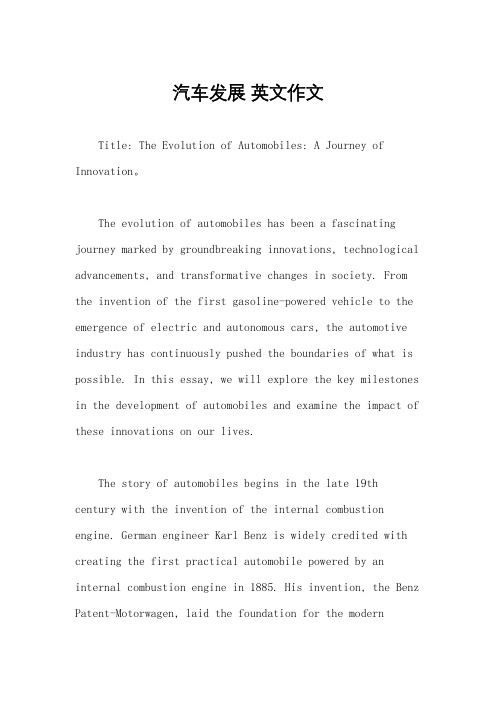
汽车发展英文作文Title: The Evolution of Automobiles: A Journey of Innovation。
The evolution of automobiles has been a fascinating journey marked by groundbreaking innovations, technological advancements, and transformative changes in society. From the invention of the first gasoline-powered vehicle to the emergence of electric and autonomous cars, the automotive industry has continuously pushed the boundaries of what is possible. In this essay, we will explore the key milestones in the development of automobiles and examine the impact of these innovations on our lives.The story of automobiles begins in the late 19th century with the invention of the internal combustion engine. German engineer Karl Benz is widely credited with creating the first practical automobile powered by an internal combustion engine in 1885. His invention, the Benz Patent-Motorwagen, laid the foundation for the modernautomobile industry. The invention of the automobile revolutionized transportation, offering people a faster, more convenient way to travel long distances.Throughout the early 20th century, automobiles underwent rapid development and improvement. Henry Ford's introduction of the assembly line in 1913 revolutionized the manufacturing process, making cars more affordable and accessible to the general public. Mass production techniques allowed Ford to produce cars at a much lower cost, paving the way for the widespread adoption of automobiles.The mid-20th century brought significant advancements in automotive technology, including the development of safety features such as seat belts, airbags, and anti-lock braking systems. These innovations helped reduce the number of injuries and fatalities caused by car accidents, making driving safer for everyone.In recent decades, the focus of automotive innovation has shifted towards sustainability and environmentalresponsibility. Concerns about climate change and air pollution have led to the development of electric andhybrid vehicles as alternatives to traditional gasoline-powered cars. Electric cars offer several advantages over their gasoline counterparts, including lower emissions, reduced reliance on fossil fuels, and lower operating costs.Furthermore, advancements in battery technology have made electric vehicles more practical and affordable for consumers. Companies like Tesla have played a significant role in popularizing electric cars and pushing the boundaries of what is possible with battery technology. The widespread adoption of electric vehicles has the potentialto significantly reduce greenhouse gas emissions andmitigate the impact of climate change.In addition to electric vehicles, the automotiveindustry is also exploring the potential of autonomous vehicles to revolutionize transportation. Autonomous orself-driving cars use a combination of sensors, cameras,and artificial intelligence to navigate roads and make driving decisions without human intervention. While fullyautonomous cars are still in the early stages of development, they have the potential to dramatically improve road safety, reduce traffic congestion, and increase mobility for people with disabilities or limited mobility.In conclusion, the evolution of automobiles has been a remarkable journey marked by innovation, technological advancement, and societal change. From the invention of the first gasoline-powered car to the development of electric and autonomous vehicles, the automotive industry has continuously pushed the boundaries of what is possible. As we look to the future, it is clear that automobiles will continue to play a vital role in shaping the way we live, work, and travel. By embracing innovation and sustainability, we can ensure that the cars of tomorrow are safer, cleaner, and more efficient than ever before.。
外文翻译 外文文献 英文文献 国内混合动力汽车发展
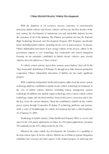
China Hybrid Electric Vehicle DevelopmentWith the depletion of oil resources, increase awareness of environmental protection, hybrid vehicles and electric vehicles will become the first decades of the new century, the development of mainstream cars and automobile industry become the consensus of all of the industry. The Chinese government also has the National High Technology Research and Development Program (863 Program) specifically listed, including hybrid vehicles, including electric cars of major projects. At present, China's independent innovation of new energy vehicles in the process, adhere to the government support to core technology, key components and system integration focusing on the principles established in hybrid electric vehicles, pure electric vehicles, fuel cell vehicles as a "three vertical "To vehicle control systems, motor drive systems, power battery / fuel cell for the "three horizontal" distribution of R & D, through close links between production cooperation, China's independent innovation of hybrid cars has made significant progress.With completely independent intellectual property rights form the power system technology platform, established a hybrid electric vehicle technology development. Is the core of hybrid vehicles batteries (including battery management system) technology. In addition, also include engine technology, motor control, vehicle control technology, engine and electrical interface between the power conversion and is also the key. From the current situation, China has established a hybrid electric vehicle power system through Cooperative R & D technology platforms and systems, made a series of breakthroughs for vehicle development has laid a solid foundation. As of January 31, 2009,Technology in hybrid vehicles, China Intellectual Property Office to receive and open for the 1116 patent applications in China. In 1116 patent applications, invention 782 (authority for the 107), utility model for the 334.Mastered the entire vehicle key development, the formation of a capability to develop various types of electric vehicles. Hybrid cars in China in systems integration, reliability, fuel economy and other aspects of the marked progress in achieving fueleconomy of different technical solutions can be 10% -40%. Meanwhile, the hybrid vehicle automotive enterprises and industrial R & D investment significantly enhanced, accelerating the pace of industrialization. Currently, domestic automakers have hybrid vehicles as the next major competitive products in the strategic high priority, FAW, Dongfeng, SAIC Motor, Changan, Chery, BYD, etc. have put a lot of manpower, material resources,Hybrid prototyping has been completed, and some models have achieved low-volume market.FAW GroupDevelopment Goal: By 2012, the Group plans to build an annual capacity of 11,000 hybrid cars, hybrid bus production base of 1000.FAW Group since 1999 and a new energy vehicles for theoretical research and development work, and the development of a red car performance hybrid sample. "15" period, the FAW Group is committed to the national "863" major project in the "red card in series hybrid electric vehicle research and development" mission, officially began the research and development of new energy vehicles. Beginning in 2006, FAW B70 in the Besturn, based on the technology for hybrid-based research, the original longitudinal into transverse engine assembly engine assembly, using a transverse engine and dual-motor hybrid technology. At the same time, FAW also pay close attention to the engine, mechanical and electrical integration, transmission, vehicle control networks, vehicle control systems development, the current FAW hybrid electric car has achieved 42% fuel saving effect, reached the international advanced level.Jiefang CA6100HEV Hybrid Electric BusFAW "Liberation brand CA6100HEV Hybrid Electric Bus" project is a national "863" electric vehicle major projects funded project, with pure electric drive, the engine alone drives (and charge), the joint drive motor starts the engine, and sliding regenerative braking 5 kinds of basic operation. The power hybrid electric bus and economy to the leading level, 38% fuel economy than traditional buses, emissions reduced by 30%.Red Flag CA7180AE hybrid carsRed Flag hybrid cars CA7180AE according to the national "863 Plan" is the first in complete with industrial prospects of the car, it is built on the basis of red car with good performance and operational smoothness. Series which is a hybrid sedan, the luxury car ,0-100km acceleration time of 14s, fuel-efficient than traditional cars by about 50%, Euro Ⅲemission standard.Besturn B70 hybrid carsBesturn B70 Hybrid cars using petrol - electric hybrid approach. Dual motor power system programs, mixed degree of 40/103, is all mixed (Full-Hybrid, also known as re-mixed) configurations. Besturn B70 Hybrid cars are petrol version costs two to three times Besturn models, mass production will be gradually reduced after the costs, even if this hybrid version Besturn market, the price certainly higher than the existing Besturn models, but high the price of petrol will not exceed 30% version of Besturn models.SAICDevelopment Goals: 2010 launch in the mixed hybrid cars, plug-in 2012, SAIC strong mix of cars and pure electric cars will be on the market.In the R & D on new energy vehicles, SAIC made clear to focus on hybrid, fuel cell for the direction, and speed up the development of alternative products. Hybrid vehicles, fuel cell vehicles, alternative fuel vehicles as a new energy strategy SAIC three key.2010 SAIC Roewe 750 hybrid cars in the mix will be put on the market, during the World Expo in Shanghai, SAIC will put 150 hybrid cars in the Expo Line on the River Run. 2012 Roewe 550 plug-in hybrid cars will be strong market, the current car's power system has been launched early development and progress.Apply the new hybrid bus moving on the 1stApply the new hybrid bus moving on the 1st Academy of Engineering by the SAIC and Shanghai Jiaotong University and other units jointly developed with independent intellectual property rights. Existing cities in the Sunwin Bus Powerplatform, "the new dynamic application No. 1" uses a parallel hybrid electric vehicle drive program, so that hybrid electric vehicle operating conditions in the electric air-conditioning, steering, braking and other accessories still able to work without additional electric system, while use of super capacitors, to improve starting power, braking energy recovery efficiency, thereby enhancing vehicle dynamic performance, reduce fuel consumption. Car length 10m, width 2.5m, high-3.2m, can accommodate 76 people.Roewe 750 hybrid carsRoewe 750 hybrid cars in the mixed system with BSG (Belt drive start generating one machine), with "smart stop zero-emission" and "environmental protection and the power of both the" two prominent features of a top speed of 205 km / h, the maximum added driving range of up to 500 km. As for the industrialization of SAIC's first own-brand hybrid car, the Roewe 750 hybrid integrated hybrid fuel-efficient cars can achieve rates of around 20%.Dongfeng Motor GroupDevelopment Goals: Plans move into 33 billion in 10 years to develop a range of environmentally friendly hybrid vehicles, including cars.EQ7200HEV hybrid carsEQ7200HEV hybrid cars are "863" project of major projects and major strategic projects of Dongfeng Motor Corporation. The car is EQ7200-Ⅱmodel (Fengshen Bluebird cars) is based on an electronically controlled automatic transmission with innovative electromechanical coupling in parallel programs, configure DC brushless motor and nickel-hydrogen batteries, plans to "10 5 "during the industrialization. Industrialization, the vehicle cost more than EQ7200 cars increase in costs ≤30%.EQ61100HEV Hybrid Electric BusEQ61100HEV electric hybrid bus by Dongfeng Vehicle Company Limited Joint Beijing Jiaotong University, Beijing, China Textile Co., Ltd. and Hunan sharp Electromechanical Technology Co., Ltd. jointly developed Shenzhou. EQ61100HEV hybrid electric bus with switched reluctance motor, Cummins ISBe1504 cylinder common rail electronic injection diesel engine, new chassis design of the system,electronically controlled automatic transmission and innovative electromechanical coupling parallel program. In the annual output reached 200, the vehicle cost more than the increase in automobile engine equipped with 6CT ≤30%.China ChanganDevelopment Goals: the next three years, the formation of different grades, different purposes, carry a different system of mixed platforms, weak mix of scale, strong mixed industrial R & D capabilities, covering commercial, A grade, B grade, C grade products. 2014 will achieve sales of new energy vehicles 150 000 2020 sales of new energy vehicles for more than 500,000."Eleventh Five-Year Plan" period, Chang-an increased investment in clean energy vehicles, a diversified energy technologies to carry out exploratory research. Environmental protection through energy-saving models continues to introduce new technology to lead the industry to upgrade and fully utilize and mobilize global resources, Chang'an in the middle hybrid cars, hybrid cars and other technological strength of the field are explored. Chang's first hybrid car long Anjie Xun HEV was successfully listed in June 2009; the first batch of 20 hybrid taxis Long An Zhixiang in January of this year officially put into operation in Chongqing.CheryDevelopment Goals: after 2010, more than half of Chery's products carry different levels of hybrid systems.From 2003 to 2008, mainly mixed with moderate Chery hybrid cars and energy saving system development, and industrialization; Chery in Wuhu, a taxi has been carried out on probation, fuel consumption will be reduced by 10% to 30% to reach Europe ⅣStandard. Since 2004, Chery hybrid cars mainly for the development of strong and industrialization. Chery hybrid car fuel consumption target to reach 100 km 3 liters, to reach Europe and the United States emissions regulations.Chery A5BSGChery A5BSG is a weak parallel hybrid electric car, using fuel engines, electric engines complementary mode, the two different power sources in the car while driving to work together or separately, through this combination to achieve the leastfuel consumption and exhaust emissions, in order to achieve fuel efficiency and environmental protection purposes. Compared with the conventional car, the car in urban conditions can save 10% -15% of fuel and reduce carbon dioxide emissions by about 12%, while costs increased by only about 25% -30%.Chery A5ISGChery A5 ISG hybrid power system consists of "1.3L gasoline engine + 5-speed manual transmission +10 kW motor +144 V Ni-MH battery," the composition of the battery system used by the Johnson Controls developed "plug-in" nickel metal hydride (Ni-MH), motor with permanent magnet synchronous motor and with the motor control system, inverter and DC / DC converters. The system enables the vehicle power to 1.6L displacement level and rate of 30% fuel savings and significantly reduce the emissions of Euro V standards.Cherry A3ISGChery A3 ISG has 1.3L473F gasoline engine and equipped with 10KW motor. By gasoline engines and electric motors with torque overlay approach to dynamic mixed to provide the best vehicle power operating efficiency and energy saving environmental protection goals. Chery A3 ISG also has Stop_Restart the idling stop function such as flame start to start (BSG function), to reduce red light in the vehicle stopped or suspended when the fuel consumption and emissions expenses.FY 2BSGFY 2 BSG carry 1.5LSQR477F inline four-cylinder engine configuration BSG start / stop and so one electric motor, red light in the vehicle stopped the driver into the gap, it will automatically enter standby mode to turn off the engine, starting moments after the entry block automatically start the engine. FY 2 BSG vehicle average fuel consumption than the 1.5L petrol cars reduce about 5-10%, average fuel consumption can be reduced up to 15%.BYD AutoDevelopment Goal: to electric cars as a transitional mode, the electric car as the ultimate goal, the development of new energy cars BYD.BYD follow the "independent research and development, independent production, independent brand" development path, and the "core technology, vertical integration" development strategy, as the transition to dual-mode electric vehicles, electric vehicles as the ultimate goal, the development of BYD new energy vehicles.国内混合动力汽车发展随着石油资源的枯竭、人们环保意识的提高,混合动力汽车及电动汽车将成为新世纪前几十年汽车发展的主流,并成为我国汽车界所有业内人士的共识。
汽车发展历史的有关介绍英语作文
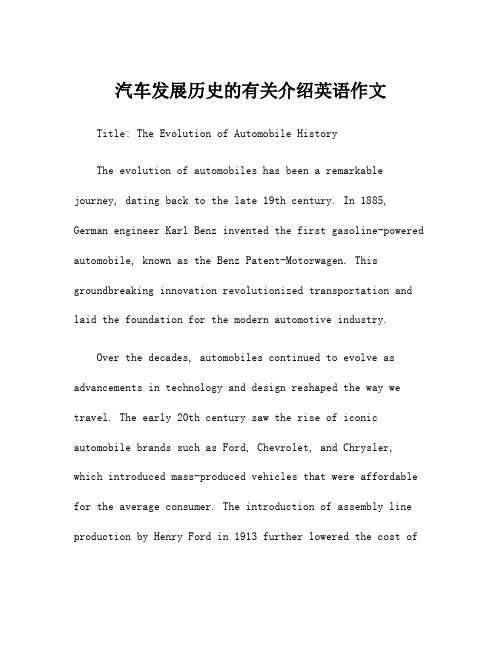
汽车发展历史的有关介绍英语作文Title: The Evolution of Automobile HistoryThe evolution of automobiles has been a remarkable journey, dating back to the late 19th century. In 1885, German engineer Karl Benz invented the first gasoline-powered automobile, known as the Benz Patent-Motorwagen. This groundbreaking innovation revolutionized transportation and laid the foundation for the modern automotive industry.Over the decades, automobiles continued to evolve as advancements in technology and design reshaped the way we travel. The early 20th century saw the rise of iconic automobile brands such as Ford, Chevrolet, and Chrysler, which introduced mass-produced vehicles that were affordable for the average consumer. The introduction of assembly line production by Henry Ford in 1913 further lowered the cost ofautomobiles, making car ownership more accessible to the general public.As the automobile industry grew, so did the range of vehicles available to consumers. From compact sedans to rugged trucks and sleek sports cars, automakers began producing a diverse array of models to cater to different needs and preferences. Innovations such as fuel injection, power steering, and anti-lock brakes enhanced the performance and safety of cars, making them more reliable and efficient.In the mid-20th century, the automotive industry experienced significant advancements with the development of electric cars and hybrid vehicles. Companies like Toyota and Tesla pioneered the use of alternative fuels and sustainable technologies, leading to a more eco-friendly approach to transportation. Electric cars offer zero-emission driving and reduced reliance on fossil fuels, making them a popular choice for environmentally conscious consumers.In recent years, the rise of autonomous vehicles has revolutionized the concept of driving altogether. Companies like Google and Uber have invested heavily in self-driving technology, with the goal of creating safer, more efficient transportation systems. Autonomous vehicles have the potential to drastically reduce accidents and traffic congestion, while also improving accessibility for individuals with disabilities.Looking ahead, the future of automobiles is bright with possibilities. Advancements in artificial intelligence, electric propulsion, and connectivity are paving the way for a new era of smart cars that can communicate with each other and with the surrounding infrastructure. These innovations have the potential to transform the way we travel, making transportation more convenient, sustainable, and efficient.In conclusion, the evolution of automobile history has been a testament to human ingenuity and innovation. From theinvention of the first gasoline-powered car to the development of electric and autonomous vehicles, the automotive industry has continuously pushed the boundaries of what is possible. As we look to the future, it is clear that the automobile will continue to play a vital role in shaping the way we live and move.。
关于汽车发展史的英语作文
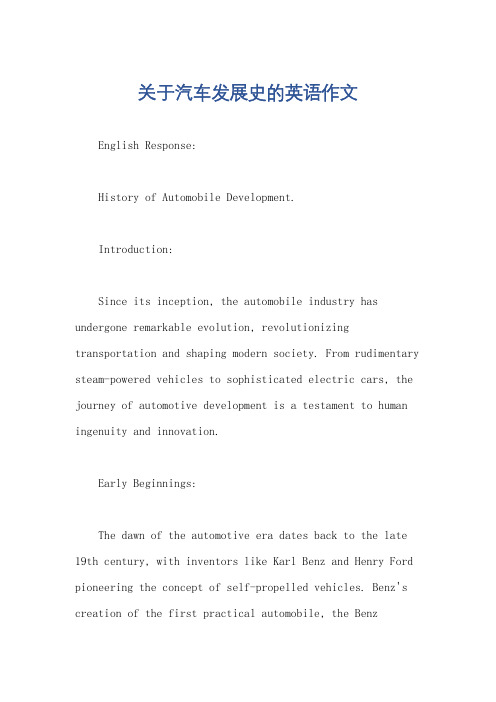
关于汽车发展史的英语作文English Response:History of Automobile Development.Introduction:Since its inception, the automobile industry has undergone remarkable evolution, revolutionizing transportation and shaping modern society. From rudimentary steam-powered vehicles to sophisticated electric cars, the journey of automotive development is a testament to human ingenuity and innovation.Early Beginnings:The dawn of the automotive era dates back to the late 19th century, with inventors like Karl Benz and Henry Ford pioneering the concept of self-propelled vehicles. Benz's creation of the first practical automobile, the BenzPatent-Motorwagen in 1886, marked a significant milestone. Meanwhile, Ford's introduction of the assembly line technique in the early 20th century revolutionized mass production, making cars more affordable and accessible to the public.Technological Advancements:Over the decades, automotive technology has witnessed remarkable advancements. The transition from internal combustion engines to electric propulsion is one of the most notable trends of the 21st century. Electric vehicles (EVs) offer numerous advantages, including environmental sustainability and reduced dependency on fossil fuels. Companies like Tesla have played a pivotal role in popularizing EVs, showcasing the potential for innovation in the automotive sector.Innovations in Safety and Comfort:Apart from propulsion technology, improvements in safety and comfort have also defined the evolution ofautomobiles. Features such as airbags, anti-lock braking systems (ABS), and advanced driver assistance systems (ADAS) have significantly enhanced vehicle safety, reducing the likelihood of accidents and fatalities. Moreover, developments in automotive design and materials have led to more ergonomic and luxurious interiors, providing passengers with a comfortable and enjoyable travel experience.Challenges and Opportunities:Despite the progress, the automotive industry faces various challenges, including environmental concerns, regulatory requirements, and changing consumer preferences. However, these challenges also present opportunities for innovation and growth. Concepts like autonomous vehiclesand shared mobility services hold the potential to reshape the future of transportation, offering efficient and sustainable solutions to urban mobility problems.Conclusion:In conclusion, the history of automobile development is a testament to human creativity and perseverance. From humble beginnings to the present day, the automotive industry has continuously evolved, driven by technological innovation and changing societal needs. As we look towards the future, the journey of automotive development promises exciting possibilities, shaping the way we live, work, and travel.---。
汽车的历史发展英语作文

The Historical Development of AutomobilesThe automobile, a remarkable invention that has profoundly transformed transportation and society, has come a long way since its inception. Tracing the historical development of the automobile reveals a fascinating journey of innovation, technology, and progress.Early BeginningsThe first steam-powered automobile was invented in the late 18th century, but it was not until the mid-19th century that significant progress was made. In 1866, the first practical gasoline-powered internal combustion engine was developed by Nikolaus Otto, marking a significant milestone in automotive history. This engine, known as the Otto cycle, laid the foundation for the modern internal combustion engine.The Horseless CarriageIn 1885, Carl Benz patented the first gasoline-powered automobile, which he named the "Motorwagen." This groundbreaking invention was followed by Gottlieb Daimler's development of the first four-stroke internal combustion engine in 1886. These early automobiles, often referred to as "horseless carriages," were slow and cumbersome compared to today's vehicles but represented a significant leap forward in transportation technology.The Growth of the Automobile IndustryThe early 20th century saw rapid growth in the automobile industry. Henry Ford's introduction of the Model T in 1908 revolutionized mass production, making automobiles more accessible and affordable to the average American. This era also saw the development of key automotive features such as electric starters, headlights, and taillights, which improved safety and convenience.Modern InnovationsIn recent decades, the automobile has continued to evolve with advancements in technology and design. Electric vehicles, self-driving technology, and connected car features such as GPS navigation and infotainment systems are just a few examples of modern innovations that have transformed the automotive landscape.The Future of AutomobilesAs we look ahead, the future of automobiles appears increasingly bright. With advancements in technology, we can expect to see even more innovative features and designs emerge. Autonomous vehicles, electric vehicles with longer ranges, and sustainable transportation solutions are among the exciting possibilities that lie ahead.In conclusion, the historical development of automobiles is a remarkable testament to human ingenuity and progress. From the early steam-powered vehicles to the modern electric and autonomous cars, the automobile has come a long way and continues to evolve, promising an exciting future for transportation and society.汽车是一项深刻改变交通运输和社会的杰出发明,自其诞生以来已经经历了漫长的发展历程。
汽车发展英文作文
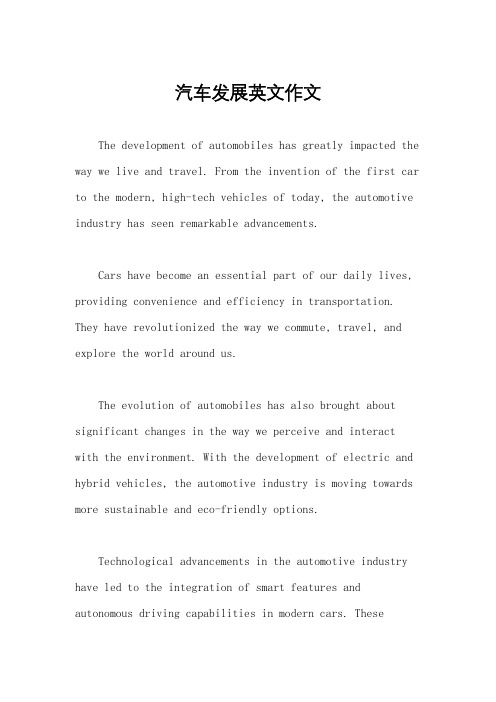
汽车发展英文作文The development of automobiles has greatly impacted the way we live and travel. From the invention of the first car to the modern, high-tech vehicles of today, the automotive industry has seen remarkable advancements.Cars have become an essential part of our daily lives, providing convenience and efficiency in transportation. They have revolutionized the way we commute, travel, and explore the world around us.The evolution of automobiles has also brought about significant changes in the way we perceive and interact with the environment. With the development of electric and hybrid vehicles, the automotive industry is moving towards more sustainable and eco-friendly options.Technological advancements in the automotive industry have led to the integration of smart features and autonomous driving capabilities in modern cars. Theseinnovations have not only enhanced the safety and comfort of driving but also paved the way for the future of transportation.The future of automobiles holds even more exciting possibilities, with the potential for flying cars, self-driving vehicles, and alternative fuel sources. As the automotive industry continues to evolve, it will undoubtedly shape the way we travel and experience the world for generations to come.。
汽车的历史发展英语作文
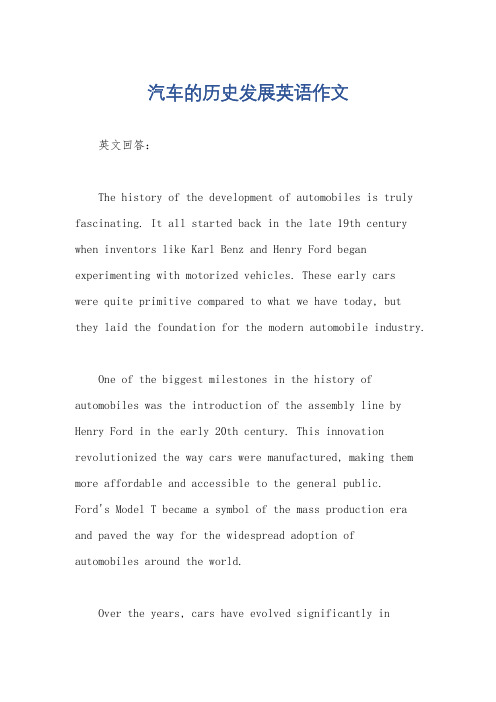
汽车的历史发展英语作文英文回答:The history of the development of automobiles is truly fascinating. It all started back in the late 19th century when inventors like Karl Benz and Henry Ford began experimenting with motorized vehicles. These early carswere quite primitive compared to what we have today, but they laid the foundation for the modern automobile industry.One of the biggest milestones in the history of automobiles was the introduction of the assembly line by Henry Ford in the early 20th century. This innovation revolutionized the way cars were manufactured, making them more affordable and accessible to the general public.Ford's Model T became a symbol of the mass production era and paved the way for the widespread adoption ofautomobiles around the world.Over the years, cars have evolved significantly interms of design, technology, and performance. From the sleek and aerodynamic sports cars of the 1960s to the fuel-efficient hybrids and electric vehicles of today, the automotive industry has come a long way. Innovations like automatic transmission, power steering, and advanced safety features have made driving more convenient and safer than ever before.I remember growing up in the 90s and dreaming about owning a flashy sports car one day. The thrill of driving fast and feeling the wind in my hair was something I always looked forward to. But now, as I've gotten older, I appreciate the comfort and reliability of a luxury sedan or SUV. The advancements in car technology have made long road trips a breeze, with features like adaptive cruise control and lane-keeping assist taking the stress out of driving.Overall, the history of automobiles is a testament to human ingenuity and innovation. From the early pioneers of the industry to the cutting-edge technologies of today, cars have become an essential part of our daily lives. Whether it's commuting to work, running errands, or goingon a road trip, cars have made transportation more convenient and enjoyable for people all over the world.中文回答:汽车的发展历史真是令人着迷。
汽车发展英文作文怎么写

汽车发展英文作文怎么写英文回答:The development of automobiles has revolutionized the way humans travel and transport goods. From the invention of the first steam-powered car in the late 18th century to the sleek, autonomous vehicles of today, the automobile has undergone a remarkable transformation.In the early days, cars were primarily used as luxury items for the wealthy. They were expensive, unreliable, and impractical for everyday use. However, as technology advanced and mass production techniques were developed, the automobile became more affordable and accessible to the general public.The widespread adoption of cars had a profound impact on society. It created new industries, such as automotive manufacturing and transportation, and it made it possible for people to travel farther and more easily. Cars alsoplayed a significant role in the development of suburbs and the growth of the middle class.Today, the automobile industry is a major global economic engine. It employs millions of people andgenerates trillions of dollars in revenue. The advancementof technology has led to the development of increasingly sophisticated and fuel-efficient vehicles, and the futureof the automobile is likely to be shaped by emerging technologies such as electric vehicles and autonomous driving.中文回答:汽车的发展彻底改变了人类旅行和运输货物的方式。
关于汽车发展史的英语作文

关于汽车发展史的英语作文英文回答:History of Automobiles.The development of automobiles has revolutionized human transportation. In the early 19th century, inventors were experimenting with steam-powered vehicles. In 1885, Karl Benz developed the first internal combustion engine, which used gasoline as fuel. This invention marked the birth of the modern automobile.In the early 20th century, automobiles became more affordable and accessible to the general public. HenryFord's introduction of the Model T in 1908 made cars affordable for the average American family. Over the years, automobiles have undergone significant improvements in performance, safety, and comfort.Today, automobiles are an integral part of our dailylives. They provide convenient and efficient transportation, allowing us to travel far distances quickly and easily. Automobiles have also played a crucial role in economic development, creating jobs and fostering trade.中文回答:汽车发展史。
汽车的历史发展英语作文
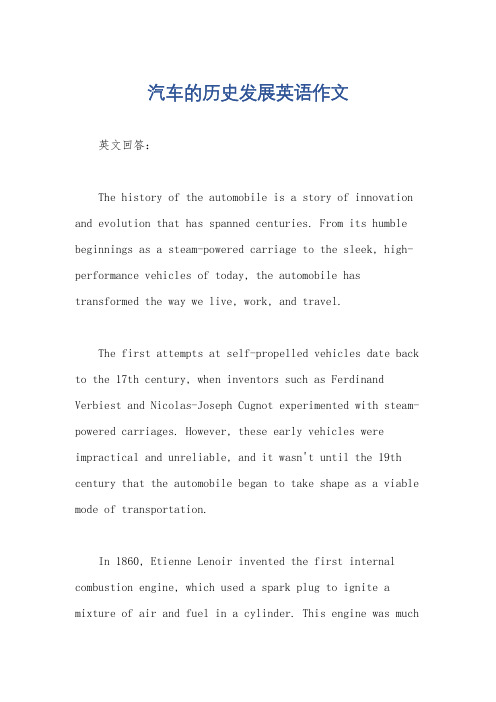
汽车的历史发展英语作文英文回答:The history of the automobile is a story of innovation and evolution that has spanned centuries. From its humble beginnings as a steam-powered carriage to the sleek, high-performance vehicles of today, the automobile has transformed the way we live, work, and travel.The first attempts at self-propelled vehicles date back to the 17th century, when inventors such as Ferdinand Verbiest and Nicolas-Joseph Cugnot experimented with steam-powered carriages. However, these early vehicles were impractical and unreliable, and it wasn't until the 19th century that the automobile began to take shape as a viable mode of transportation.In 1860, Etienne Lenoir invented the first internal combustion engine, which used a spark plug to ignite a mixture of air and fuel in a cylinder. This engine was muchmore efficient than steam engines, and it paved the way for the development of the modern automobile.In 1885, Karl Benz built the first successful gasoline-powered automobile. Benz's vehicle was a three-wheeled, open-top carriage that could reach speeds of up to 10 miles per hour. This invention marked the birth of the modern automobile industry, and it wasn't long before other inventors and manufacturers entered the field.In 1893, Henry Ford founded the Ford Motor Company, which would go on to revolutionize the automobile industry. Ford's Model T, introduced in 1908, was the first mass-produced automobile, and it made cars affordable for millions of Americans.The early 20th century saw rapid advancements in automobile technology. Electric starters, headlights, and closed bodies became standard features, and cars became more comfortable and convenient to drive. By the 1920s, the automobile had become an essential part of American life, and it continued to play a vital role in the development ofthe United States and other countries around the world.Today, the automobile industry is a global powerhouse, with manufacturers from around the world competing for market share. Cars have become increasingly sophisticated, with advanced safety features, fuel-efficient engines, and cutting-edge technology. The future of the automobile is uncertain, but it is clear that this remarkable invention will continue to play a major role in our lives.中文回答:汽车的历史是一部跨越数个世纪的创新和演变史。
英语作文汽车发展史英语作文
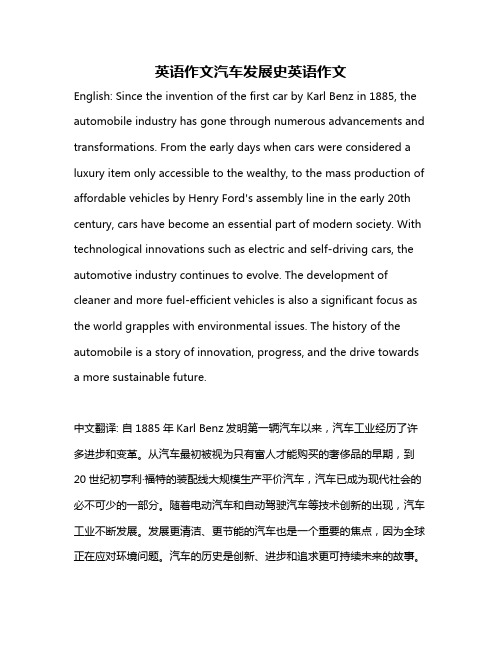
英语作文汽车发展史英语作文English: Since the invention of the first car by Karl Benz in 1885, the automobile industry has gone through numerous advancements and transformations. From the early days when cars were considered a luxury item only accessible to the wealthy, to the mass production of affordable vehicles by Henry Ford's assembly line in the early 20th century, cars have become an essential part of modern society. With technological innovations such as electric and self-driving cars, the automotive industry continues to evolve. The development of cleaner and more fuel-efficient vehicles is also a significant focus as the world grapples with environmental issues. The history of the automobile is a story of innovation, progress, and the drive towards a more sustainable future.中文翻译: 自1885年Karl Benz发明第一辆汽车以来,汽车工业经历了许多进步和变革。
- 1、下载文档前请自行甄别文档内容的完整性,平台不提供额外的编辑、内容补充、找答案等附加服务。
- 2、"仅部分预览"的文档,不可在线预览部分如存在完整性等问题,可反馈申请退款(可完整预览的文档不适用该条件!)。
- 3、如文档侵犯您的权益,请联系客服反馈,我们会尽快为您处理(人工客服工作时间:9:00-18:30)。
The development of automobileAs the world energy crisis and the war and the energy consumption of oil -- and are full of energy in one day someday it will disappear without a trace. Oil is not inresources. So in oil consumption must be clean before finding a replacement. With the development of science and technology the progress of the society people invented the electric car. Electric cars will become the most ideal of transportation.In the development of world each aspect is fruitful especially with the automobile electronic technology and computer and rapid development of the information age. The electronic control technology in the car on a wide range of applications the application of the electronic device cars and electronic technology not only to improve and enhance the quality and the traditional automobile electrical performance but also improve the automobile fuel economy performance reliability and emission spurification. Widely used in automobile electronic products not only reduces the cost and reduce the complexity of the maintenance. From the fuel injection engine ignition devices air control and emission control and fault diagnosis to the body auxiliary devices are generally used in electronic control technology auto development mainly electromechanical integration. Widely used in automotive electronic control ignition system mainly electronic control fuel injection system electronic control ignition system electronic control automatic transmission electronic control ABS/ASR control system electronic control suspension system electronic control power steering system vehicle dynamic control system the airbag systems active belt system electronic control system and the automatic air-conditioning and GPS navigation system etc. With the system response the use function of quick car high reliability guarantees of engine power and reduce fuel consumption and emission regulations meet standards.The car is essential to modern traffic tools. And electric cars bring us infinite joy will give us the physical and mental relaxation. Take for example automatic transmission in road can not on the clutch can achieve automatic shift and engine flameout not so effective improve the driving convenience lighten the fatigue strength. Automatic transmission consists mainly of hydraulic torque converter gear transmission pump hydraulic control system electronic control system and oil cooling system etc. The electronic control of suspension is mainly used to cushion the impact of the body and the road to reduce vibration that car getting smooth-going and stability. When the vehicle in the car when the road uneven road can according to automatically adjust the height. When the car ratio of height low set to gas or oil cylinder filling or oil. If is opposite gas or diarrhea. To ensure and improve the level of driving cars driving stability. Variable force power steering system can significantly change the driver for the work efficiency and the state so widely used in electric cars. VDC to vehicle performance has important function it can according to the need of active braking to change the wheels of the car car motions of state and optimum control performance and increased automobile adhesion controlling and stability. Besides these appear beyond 4WS 4WD electric cars can greatly improve the performance of the value and ascending simultaneously. ABS braking distance is reduced and can keep turning skills effectively improve the stability of the directions simultaneously reduce tyre wear. The airbag appear in large programs protected the driver and passengers safety and greatly reduce automobile in collision of drivers and passengers in the buffer to protect the safety of life.Intelligent electronic technology in the bus to promote safe driving and that the other functions. The realization of automatic driving through various sensors. Except some smart cars equipped with multiple outside sensors can fully perception of information and traffic facilitiesand to judge whether the vehicles and drivers in danger has the independent path finding navigation avoid bump no parking fees etc. Function. Effectively improve the safe transport of manipulation reduce the pilot fatigue improve passenger comfort. Of course battery electric vehicle is the key the electric car battery mainly has: the use of lead-acid batteries nickel cadmium battery the battery sodium sulfide sodium sulfide lithium battery the battery the battery the flywheel zinc - air fuel cell and solar battery the battery. In many kind of cells the fuel cell is by far the most want to solve the problem of energy shortage car. Fuel cells have high pollution characteristics different from other battery the battery need not only external constantly supply of fuel and electricity can continuously steadily. Fuel cell vehicles FCEV can be matched with the car engine performance and fuel economy and emission in the aspects of superior internal-combustion vehicles.Along with the computer and electronic product constantly upgrading electric car open class in mature technology and perfected that drive more safe convenient and flexible comfortable. Now the electric car from ordinary consumers distance is still very far away only a few people in bandwagon. Electric cars with traditional to compete in the market the car Will was electric cars and intelligent car replaced. This is the question that day after timing will come. ABS GPS and various new 4WD 4WS electronic products and the modern era excellent performance auto tacit understanding is tie-in bring us unparalleled precision driving comfort and safety of driving.汽车的发展随着世界能源危机的持续,以及战争和能源-----石油的消耗及汽车饱有量的增加,能源在一天一天下降,终有一天它会消失的无影无踪。
